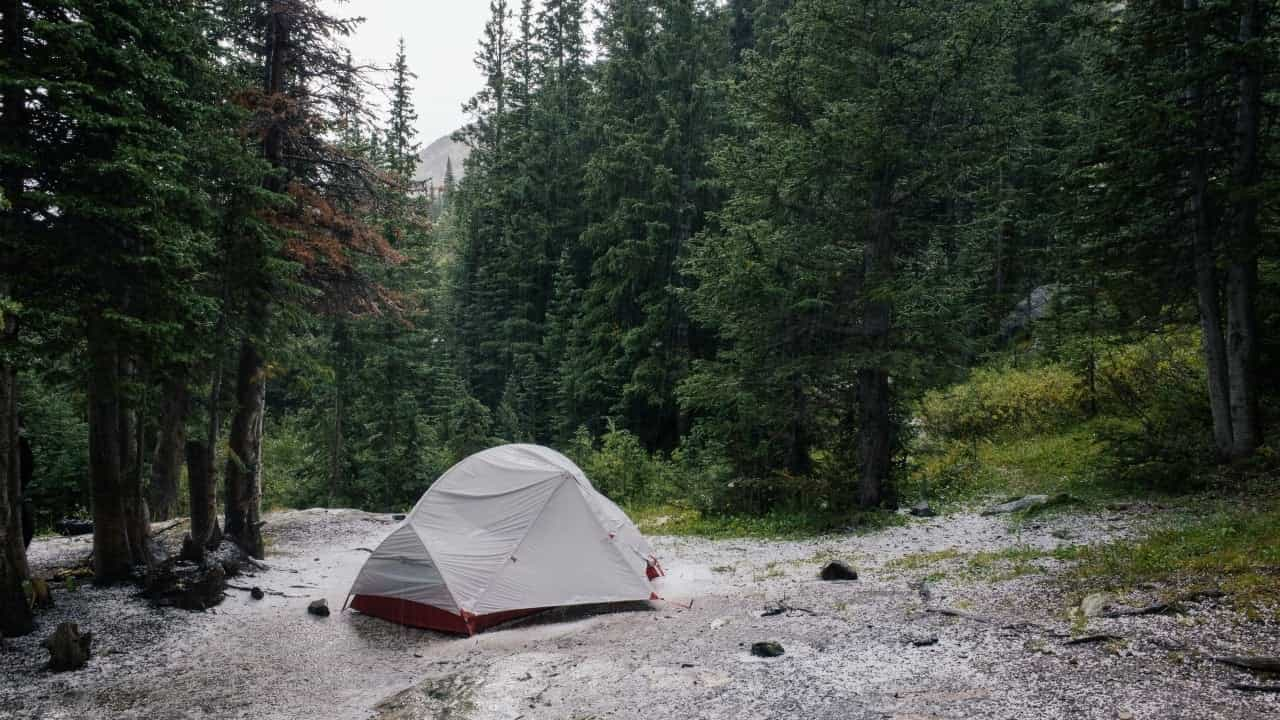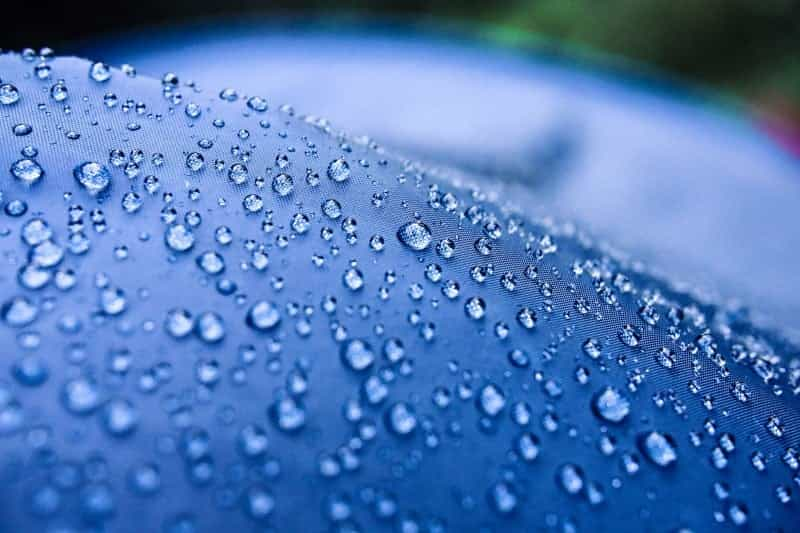Waterproofing your tent
If you’ve ever wondered what keeps the inside of your tent dry during rainy conditions, it all comes down to your tent’s waterproof coating. The trouble is, the more camping you do, the likelier it is that your tent will require a reproof. This might sound daunting, but it’s really simple to do at home, and it only requires a simple reproof product and an easy-to-follow routine that will return your tent to its former glory.

Why you may need to reproof your tent
Cotton and polycotton tents don’t need reproofing because they have naturally water-repellent properties. However, nylon or polyester tents do.
Tents made from nylon and polyester have a waterproof coating instead, usually a polyurethane coating followed by a Durable Water Repellent (DWR). Together, the two layers repel rainwater and other moisture, keeping your tent leak-free.
The more adventures your tent accompanies you on, the more the waterproof coating is worn down by friction and exposure to wind, rain and the sun. This in turn means that your tent will be less effective at repelling water. Handily, a reproof will restore your tent to working order again. It just involves applying a new waterproof coating yourself.
Signs you need to reproof your tent
1. The tent is leaking.
The biggest tell-tale sign that your tent’s waterproof coating isn’t working effectively is a leaky tent. Instead of repelling water, moisture will drench through the fabric, getting inside your tent and often causing puddles or drips.
2. The tent fabric looks flaky.
When the waterproof coating is worn down, it may start to peel away or become loose.
3. The water on the outside of your tent doesn’t form droplets.
Rain and moisture should form bead-like droplets on the outside of your tent. If they don’t, it’s likely that at least some of the water is being absorbed by the tent fabric, meaning that the tent’s waterproof coating isn’t doing its job correctly.

How to reproof your tent
1. Purchase a reproof product suitable for your tent’s fabric.
Shop for a reproof product at camping and outdoor gear stores or online retailers. These sprays usually cost anywhere between £10 and £25.
Key things to look out for are products in spray form, as this will make it easier for you to apply an even coating to your tent. The product should also say that it’s suitable for your tent’s fabric. So, check your tent’s label to find out what kind fabric it’s made from and then refer back to the product specification.
2. Choose a warm, dry day to perform your reproof.
We’d recommend doing your reproof outdoors to avoid getting the reproof product on carpets and other furnishings. However, check the weather forecast, as you’ll need dry weather for at least 24 hours to ensure that the product has time to dry. Bonus points if it’s warm outside, as this will speed up the drying process even more.
3. Pitch your tent or lay it out flat on the ground.
Waterproofing your tent is simplest if you follow our instructions on how to pitch your tent. That’s because it’s easy to miss sections of the tent when it isn’t pitched. When it’s upright, you’ll find it easier to reach and cover all of the different panels, the corners and the roof.
It’s still possible to waterproof an unpitched tent. However, prepare for the process to be trickier and take longer to do, and bear in mind that the tent will take longer to dry.
4. Clean your tent.
Your tent should be free from dirt and debris before you start the process, so follow the instructions on how to clean your tent by shaking away dirt, wiping it clean with lukewarm water and mild soap. Then, let it soak before you rinse it out and put it out to dry.
5. Check your reproof product to see if your tent should be wet or dry.
Every waterproofing product is different, so you’ll need to check whether your tent should be wet or dry before you start the application process. Depending on the instructions, you may need to dry out your tent before you begin. Otherwise, leave it damp if the instructions say so.
6. Evenly apply the reproof one panel at a time.
Apply the reproof to your tent fabric, taking things one panel at a time. You’ll want the coverage to be as even as possible, so if your reproof product doesn’t come in spray form, a brush or sponge are useful tools to apply the solution. Use a damp cloth to mop off any clumps or excess product during the process.
7. Let your tent dry for at least 24 hours.
Your reproof product may have specific instructions on how long you’ll need to leave your tent to dry. If there aren’t any, leaving your tent to dry for at least 24 hours is a good rule of thumb.
How to look after your tent and avoid needing to reproof it
Most tents that are used for a few weeks per year only need waterproofing every couple of years. However, there are some ways that campers can look after their tent and lengthen the time between reproofs.
1. Avoid camping in severe weather conditions.
When you’re camping for prolonged amounts of time in severe wet weather conditions or extremely hot weather, the rain and UV rays will wear down your tent’s waterproof coating more quickly.
2. Pitch your tent out of direct sunlight or underneath trees.
Trees and foliage will take the brunt of the sun’s UV rays or the rainfall, helping your tent’s waterproof coating to last longer.
3. Ensure that your tent is fully dry before packing it away.
When you take down your tent, it’s paramount that you take steps to ensure that your tent is completely dry before it’s packed away. Otherwise, your tent bag might become a breeding ground for mould and the fabric is likely to degrade while it’s sitting around in moisture.
4. Store your tent in a dry and cool part of your home.
When you’re not out exploring, your tent should reside in a cool and dry part of your home to ensure that no moisture gets into your tent pack and damages the fabric.
5. Check your tent regularly for holes, tears and flaky seams.
Part of looking after your tent is examining the fabric for noticeable tears or holes. Turn your tent inside out to examine the seams and keep an eye out for flaking or loose fabric.
6. Perform any tent repairs required.
Whether it’s a hole, tear, split seam or a broken tent pole, there’s always a tent repair that can put things right. Unresolved damage will only worsen over time and could put your tent out of order permanently.
Armed with a properly reproofed tent, you’ll be well-prepared for rain or sun and one step closer to keeping your tent completely leak free. For other ways to look after your tent, our guide to removing mould and mildew might come in handy.
FAQ
How often do you need to waterproof a tent?
Most tents need waterproofing every couple of years when they are used for several weeks per year.
How long does waterproofing a tent last?
A waterproofed tent should last for a couple of years if the tent is only used for several weeks per year.
Is it worth waterproofing a tent?
Waterproofing a tent will extend its life and prevent leaks, saving you the price of purchasing a new tent.
How long does it take to waterproof a tent?
Waterproofing a tent should take around 24 hours.